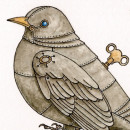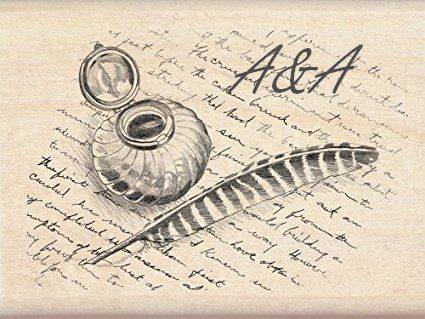A Clockwork Break
by Shawn Scarber
Last night Angie dreamed her heart had turned to a metal box with broken gears.
She pulled the lifter and positioned the sleeve under the presser footer. In one smooth motion, she guided the garment across the cloth plate. She did this for every piece of clothing, and had for the past four autumns. The sewing machine had become a part of her.
As the needle bar glided up and down, she considered her younger brother’s latest letter. Thomas promised her, after his graduation in spring, train fare from Lowell to Boston.
The city offered an easier life, he wrote. Her arduous hours, pricked fingers and watering eyes had paid for his education. Now it seemed he wished to return her favor with a respectable home, employment as his children’s governess and a furnished room where she could live out her life as a spinster.
Angie handed the garment to her left, to Susana Ward, a dirty-looking girl from Kansas. She attached the pearl buttons with some care not to soil the sleeves.
An older woman to her right handed Angie the next sleeve. Work continued that way for hours.
Then the equipment clogged. A leather engine belt had caught fire. Bruce, the machinist, had to attach another.
Angie focused her gaze toward her sewing as he worked. Another woman might catch her glancing in his direction. While he lifted the engine parts, and the muscles on his arms tightened, and his back and chest swelled with the exertion, she wondered how his black beard might feel against her bare neck and shoulders; prickly like twined hemp or yielding like a sheep’s fleece.
He repaired it quickly, as he did with all things mechanical. Angie thought again about her dreams of clockwork hearts. The equipment bustled. She pushed another sleeve through her Wilcox-Gibbs and then handed it to Susana.
In mid-September the days brought cool breezes, and the bosses left the factory windows open. Compared to most supervisors, Angie’s were pleasant. They allowed the doffers, the youngest girls who replaced empty bobbins and swept the floors, to stare at the nearby woods and river during breaks.
When the girl’s laughed aloud, many of the women, including Angie, turned to see what had attracted their attention. For a second, Angie believed a large butterfly, or some type of clumsy beetle had flown through the window.
It fluttered toward her, and she recognized its shape as a sparrow’s, but she hadn’t seen a bird colored silver before. It landed on her sewing machine’s spool pin with tiny tick-tick sounds. It hoped about and cocked its head to the side.
Angie scarcely believed what perched near her. Someone, for a reason she could not fathom, had constructed a bird made from tin. Her first impulse told her to shoo it away and continue her work, but she didn’t listen. She reached for the mechanical bird. It moved in a natural manner, like the motion God built into his own creations. It jumped back a step from her fingers.
Angie stood and gazed over the factory floor. The machines no longer whirled. Everyone gawked at her and the toy.
When it chirped, the women seated near her startled and scurried a few steps back.
Angie again reached out, this time with her hands held together as a bowl. It eased into her hold. She expected the bird to weigh more, perhaps as much as a man’s pocket watch, but it weighed the same as a child’s cotton sleeve.
While it lay in her hands the clockwork inside ticked like a heartbeat, fast and steady similar to a genuine sparrow’s. Upon closer examination she understood why its initial flight had seemed erratic. One of its metallic feathers hung loose between two others, stuck in a wing joint. The bird attempted to reach the feather, but its creator had not made it well enough for the feat.
Angie turned toward the window to find Bruce standing two polite steps behind her. The sweat from his earlier labors still clung to his shirt. He looked at the toy and held his hands together in a cup.
She placed her hands in his. Her knuckles rubbed against his callused palms. She held her hands there a moment longer than needed, so the warmth of his touch might reside on her skin. He cradled the sparrow in one hand. With the middle finger of his other he stroked along the errant feather’s edge until it slid into place with a click.
The clockwork sparrow flapped its wings, but didn’t fly away.
Bruce nodded to Angie and smiled. A glistening row of pearl button teeth showed through his cracked lips and black beard. She couldn’t help but return a smile.
She tenderly scooped the bird in her hands and walked toward the window. It opened wide to a denim blue sky and stretching pines. The doffers angled like wide-eyed puppies to get a last look of this marvel.
Angie held it low for the girls to see and they thanked her with delighted gasps, giggles and ooohs.
She raised the tin sparrow toward the open window and as quick as a needle breaks it shot to the sky.
Angie turned to a silent factory. One of the bosses set down his clipboard and clapped. The machine operators clapped and all the women and the doffers joined. The room roared with applause.
She made a modest curtsey, though she didn’t believe anyone clapped for her, maybe for the bird’s freedom or Bruce’s skill, but what had she done to deserve attention?
Maybe they clapped in appreciation of a moment, she thought. A moment she had accepted as a gift from an unlikely bird. A moment different than any they had shared, or would ever share again.
They had all stopped clapping by the time Angie returned to her station. She reached for the next sleeve to push across her cloth plate as the machines breathed to life. She gazed on Bruce without reservation as he oiled the generator, and she thought of his strong hands sliding the gears of her heart gently into place with a click.
![]()
]
Shawn Scarber lives and works in Fort Worth, Texas with his six cats, one dog and daughter. His work has appeared in Jeff Turner’s Fundamentally Challenged anthology, the webzines Sword’s Edge and Alienskin, as well as Mythos Collector Magazine.
![]()
Story © 2006 Shawn Scarber. All other content copyright © 2006 ByrenLee Press
Copyrighted by the author unless otherwise noted.
Art Director: Bonnie Brunish


